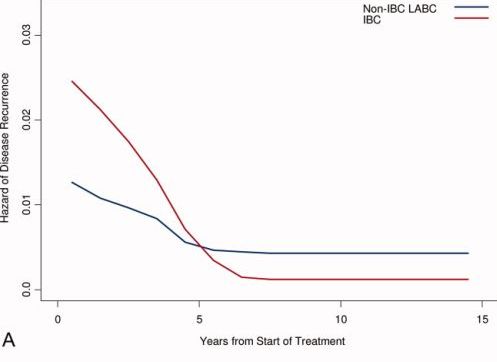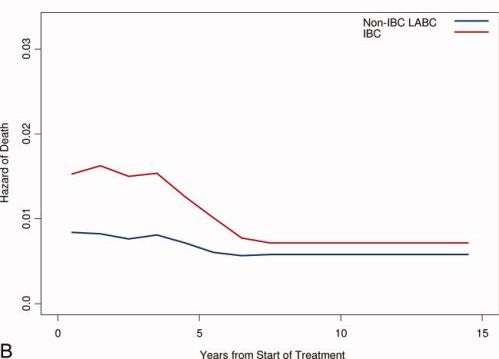Inflammatory breast cancer
The following study depicts two epidemiological hallmarks of breast cancer:
1. Bi-modal hazard rate (BMH)
2. Declining hazard following the third year after diagnosis.
Bi modal hazard (BMH) indicates that initially the patient depends
on her tumor, and its removal raises the hazard. Later on when metastasis
occurs, patient is less depndent on her tumor and the hazard declines.As cancer
progresses tumor and metastasis impinge upon vital functions and the hazard
rises.
The declining hazard indicates that with time the patient copes with
her disease better and better. The longer she lives the better her
chances to survive.
Cristofanilli et al (1) compared the prognostic features of inflammatory breast
cancer (IBC) and non-IBC locally advanced breast cancer (LABC). This retrospective
analysis consisted of 1071 patients, comprising 240 patients with IBC and
831 patients with non-IBC LABC who were enrolled in 10 consecutive clinical
trials (5 from each disease group). All patients received similar multidisciplinary
treatment. The authors measured time to disease recurrence for each individual
site from the start of treatment to the date of disease recurrence or last
follow-up (recurrence-free survival) and overall survival rates to the date
of last follow-up or death.


Original figure 3. For IBC
(red line) and LABC (blue line), plots of estimated hazard of (A) disease
progression and (B) death.
References
1. Cristofanilli M, Valero V, Buzdar AU, Kau SW, Broglio KR, Gonzalez-Angulo
AM, Sneige N, Islam R, Ueno NT, Buchholz TA, Singletary SE, Hortobagyi GN.
Inflammatory breast cancer (IBC) and patterns of recurrence: understanding
the biology of a unique disease.
Cancer. 2007 Oct 1;110(7):1436-44.